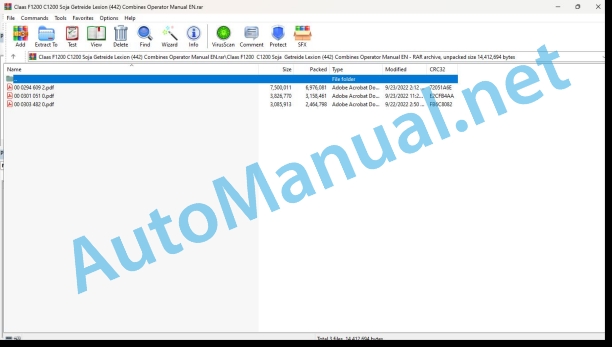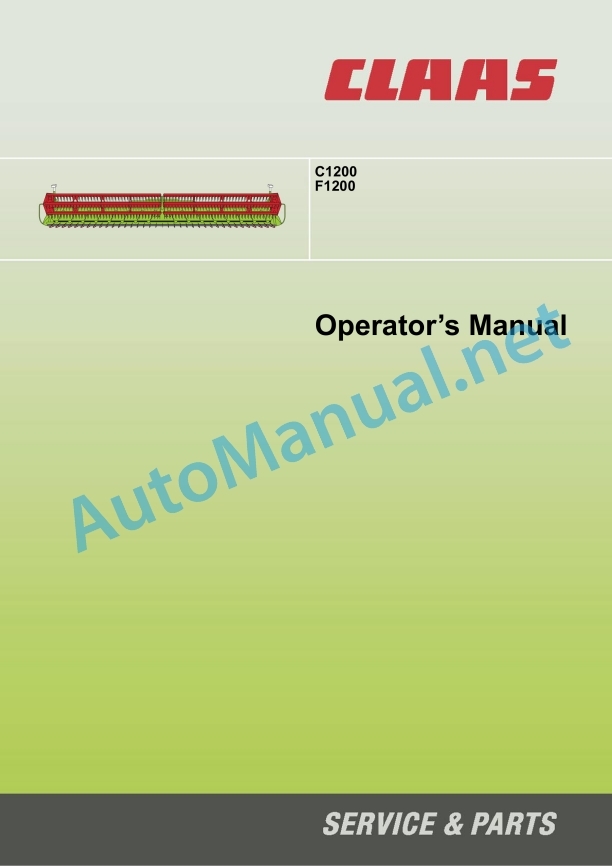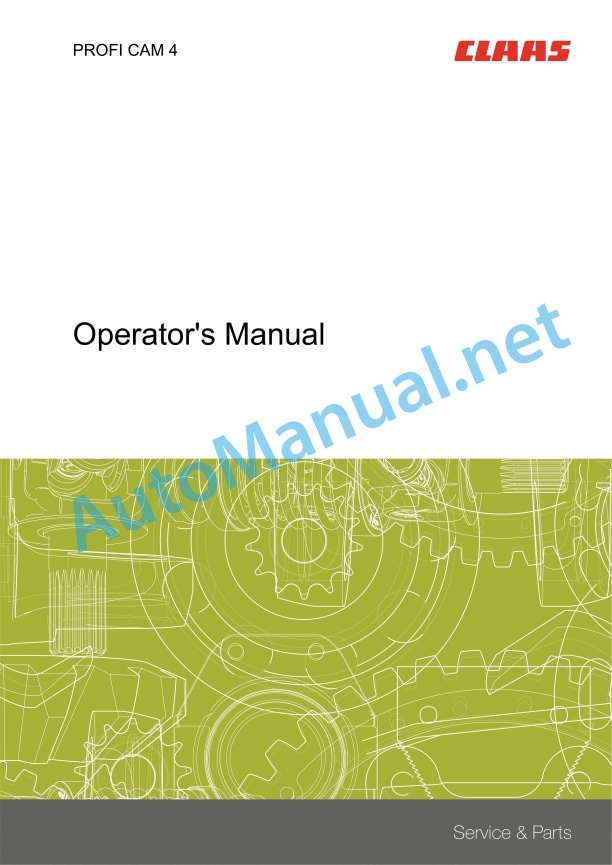Claas F1200 C1200 Soja Getreide Lexion (442) Combines Operator Manual EN
$50.00
- Model: F1200 C1200 Soja Getreide Lexion (442) Combines
- Type Of Manual: Operator Manual
- Language: EN
- Format: PDF(s)
- Size: 12.0 MB
File List:
00 0294 609 2.pdf
00 0301 051 0.pdf
00 0303 482 0.pdf
00 0294 609 2.pdf:
Contents
1 Introduction
1.1 General Information
1.1.1 How to use this manual
1.1.2 Validity of instructions
1.1.3 Specifications
1.2 Identification plates and identification numbers
1.2.1 Spare parts and technical questions
1.2.2 Identification plate
2 Overview
2.1 Overview of front attachment
2.1.1 Overview of F1200
2.1.2 Overview of C1200
3 Safety precautions
3.1 General Information
3.1.1 Important information
3.1.2 General safety and accident prevention regulations
3.1.3 Intended use
3.1.4 Reasonable foreseeable misuse
3.1.5 Precautionary measures
3.2 General safety measures
3.2.1 Applying the feeder housing safety lock
3.2.2 Disengaging feed rake conveyor safety lock
3.2.3 Engaging the reel safety lock
3.2.4 Disengaging reel safety lock
3.2.5 Attaching finger bar safety bar
3.2.6 Compressed air and water
3.2.7 Danger of injury due to escaping hydraulic liquid
3.2.8 Burn prevention
3.2.9 Oils
3.2.10 Fire prevention and explosion prevention
3.2.11 Lines, Tubes and Hoses
3.2.12 Before every start-up
3.2.13 Putting the machine into operation
3.2.14 Road travel
3.2.15 Parking
3.2.16 First aid measures
3.2.17 Decommissioning and disposal
3.3 Safety rules
3.3.1 Identification of warning and danger signs
3.4 Safety decals
3.4.1 General information on safety decals
3.4.2 Machine body
3.4.3 Reel
3.4.4 Drives
4 Specifications
4.1 F1200 – TYPE 442
4.1.1 Dimensions
4.1.2 Weights
4.1.3 Finger bar
4.1.4 Feeder unit
4.1.5 Reel
4.1.6 Safety features
4.2 C1200 – TYPE 442
4.2.1 Dimensions
4.2.2 Weights
4.2.3 Finger bar
4.2.4 Feeder unit
4.2.5 Reel
4.2.6 Safety features
5 Before initial operation
5.1 General warnings
5.2 General Information
5.2.1 Initial operation check list
5.3 Reel
5.3.1 Remove the transport safety equipment for the reel
6 Prior to each operation
6.1 General warnings
6.2 General Information
6.2.1 Checklist for putting the machine into operation
7 Mounting/removing front attachment
7.1 General warnings
7.2 General assembly and settings
7.2.1 Mounting the front attachment
7.2.2 Dismounting the front attachment
7.2.3 Adjusting the cutting angle of the HP feed rake conveyor (option) to its basic adjustment
7.3 Drives
7.3.1 Installing universal drive shaft
7.3.2 Removing universal drive shaft
7.4 Hydraulic system
7.4.1 Mounting the multi-coupler
7.4.2 Dismounting the multi-coupler
7.5 Machine body
7.5.1 Suspending front attachment
7.5.2 Interlocking the front attachment
7.5.3 Unlocking the front attachment
7.5.4 Unhitching front attachment
8 Fieldwork settings
8.1 General warnings
8.2 General adjustment for working
8.2.1 Adjusting the front attachment for harvesting soybeans (optional equipment)
8.2.2 Adjusting the front attachment for grain harvest (optional equipment)
8.3 Electrical system
8.3.1 Changing cutting height sensor over to grain harvesting (optional equipment)
8.3.2 Changing cutting height sensor over to soybean harvesting (optional equipment)
8.4 Finger bar
8.4.1 Changing finger bar over to grain harvesting (optional equipment)
8.4.2 Changing finger bar over to soybean harvesting (optional equipment)
8.4.3 Changing knives over to soybean harvesting (optional equipment)
8.4.4 Changing knives over to grain harvesting (optional equipment)
8.4.5 Installing the crop lifters (optional equipment)
8.4.6 Removing the crop lifters (optional equipment)
8.4.7 Adjusting skids (optional equipment)
9 Fieldwork
9.1 General warnings
9.2 General operation
9.2.1 Before working in the field
9.2.2 Checking the crop intake
9.2.3 Basic setting for soybean harvesting (optional equipment)
9.2.4 Basic setting for grain harvesting (optional equipment)
9.2.5 Adjusting the cutting height for harvesting soybeans (optional equipment)
9.2.6 Adjusting the cutting angle of the HP feed rake conveyor (optional equipment)
9.3 Feeder unit
9.3.1 Adjusting the stripper profile
9.3.2 Adjusting the position of the intake auger
9.3.3 Adjusting the intake auger fingers
9.3.4 Auger baffle plate extension
9.3.5 Removing the auger baffle plate extension
9.3.6 Installing the baffle plate extension
9.3.7 Adjusting the intake auger speed
9.4 Finger bar
9.4.1 Moving the table height from the machine (optional equipment)
9.4.2 Moving the table height from the front attachment (optional equipment)
9.4.3 Adjusting the knife drive speed (auxiliary equipment)
9.5 Accessory equipment
9.5.1 Installing the stripper profiles (auxiliary equipment)
9.6 Reel
9.6.1 Adjusting the reel tines
9.7 Crop divider
9.7.1 Adjusting the soybean crop divider (optional equipment)
10 Faults and remedies
10.1 General warnings
10.2 General problems and remedies
10.2.1 Crop is not picked up
10.2.2 Cutterbar is not level
10.2.3 Flow of material from the cutterbar is uneven
10.2.4 Poor crop feeding or wrapping
10.2.5 Auger stops
10.2.6 Cutting height
10.2.7 Knife problems
10.2.8 Knife is stopping
10.2.9 Material is wrapping around the reel
10.2.10 Reel fingers are touching the finger bar
10.2.11 Reel is not level
10.2.12 Reel stops
10.2.13 Reel does not rotate
10.2.14 Foreign material on the tip of the crop divider
10.3 Hydraulic system
10.3.1 Bleeding reel cylinders
10.4 Finger bar
10.4.1 Aligning the double fingers
10.4.2 Adjusting skid spring pressure (optional equipment)
10.4.3 Adjusting the control arm spring pressure (optional equipment)
10.5 Reel
10.5.1 Adjusting the reel height
10.5.2 Adjusting the reel speed sensor
11 Maintenance
11.1 General warnings
11.2 General maintenance notes
11.2.1 Fixing material
11.2.2 Maintenance operations after the harvest
11.2.3 Tightening torques for metric standard threads
11.2.4 Tightening torques for metric fine threads
11.2.5 Tightening torques for hydraulic screw fittings with ferrule according to DIN 3861
11.2.6 Tightening torques for hydraulic screw fittings and air conditioner fittings with a sealing cone and O-ring DIN 3865
11.2.7 Tightening torques for bolt fittings in plastic parts
11.3 Maintenance schedule
11.3.1 Service intervals
11.4 Lubricants chart
11.4.1 Lubricants
11.5 Drives
11.5.1 Removing the knife drive belt
11.5.2 Installing the knife drive belt
11.5.3 Adjusting the knife drive belt
11.5.4 Tensioning intake auger drive chain
11.5.5 Tensioning reel drive chain
11.5.6 Checking chain tension
11.6 Finger bar
11.6.1 Changing the knives
11.6.2 Adjusting knife clips
11.6.3 Cleaning the Covers
11.7 Reel
11.7.1 Adjusting the horizontal reel positioning slider
12 Lubrication chart
12.1 General warnings
12.2 Lubrication points
12.2.1 Lubrication intervals
12.2.2 Lubrication points – 100 h on the left
12.2.3 Lubrication points – 100 h central
12.2.4 Lubrication points – 100 h on the right
12.2.5 Lubrication points – 250 h on the left
00 0301 051 0.pdf:
PROFI CAM 3
Table of contents
1 Introduction
1.1 Notes on the manual
1.1.1 Validity of manual
1.1.2 Information about this Operator’s Manual
1.1.3 Symbols and notes
1.1.4 Optional equipment
1.1.5 Qualified specialist workshop
1.1.6 Maintenance information
1.1.7 Warranty notes
1.1.8 Spare parts and technical questions
1.2 Intended use
1.2.1 Intended use
1.2.2 Reasonably foreseeable misuse
2 Safety
2.1 Identifying warnings
2.1.1 Hazard signs
2.1.2 Signal word
2.2 Safety rules
2.2.1 Meaning of Operator’s Manual
2.2.2 Observing safety decals and warnings
2.2.3 Optional equipment and spare parts
3 Product description
3.1 Overview and method of operation
3.1.1 How the PROFI CAM works
3.2 Identification plates and identification number
3.2.1 Position of identification plates
3.2.2 Explanation of PROFI CAM identification plate
3.3 Information on the product
3.3.1 CE marking
4 Operating and control elements
4.1 Camera system
4.1.1 Camera system monitor
4.2 Menu structure
4.2.1 Main menu
4.2.2
4.2.3
4.2.4
4.2.5
4.2.6
5 Technical specifications
5.1 PROFI CAM
5.1.1 Monitor
5.1.2 Camera
5.1.3 Switch box
5.1.4 Degree of protection against foreign bodies and water
6 Preparing the product
6.1 Shutting down and securing the machine
6.1.1 Switching off and securing the machine
6.2 Prior to operation
6.2.1 Carry out prior to operation
6.2.2 Installing the sun protection
6.2.3 Aligning the camera
6.2.4 Connecting the camera electrics
7 Operation
7.1 Monitor
7.1.1 Switching on the monitor
7.1.2 Calling up the menu
7.1.3 Setting a menu item
7.1.4 Setting the image orientation
7.1.5 Setting automatic screen darkening
7.1.6 Image mirroring
7.1.7 Setting the trigger view
7.1.8 Setting the follow-up time for trigger view
7.1.9 Setting the display mode
7.1.10 Activating/deactivating a display mode
8 Faults and remedies
8.1 Electrical and electronic system
8.1.1 Overview of problems on PROFI CAM camera system
8.1.2 Replacing the switch box fuse
9 Maintenance
9.1 Maintenance intervals
9.1.1 Every 10 operating hours or daily
9.2 Camera system
9.2.1 Checking the camera system for dirt
9.2.2 Cleaning the camera
9.2.3 Cleaning the switch box
9.2.4 Cleaning the monitor
10 Placing out of operation and disposal
10.1 General Information
10.1.1 Putting out of operation and disposal
11 Technical terms and abbreviations
11.1 Abbreviations
11.1.1 Units
11.1.2 Abbreviations
11.1.3 Technical terms
00 0303 482 0.pdf:
PROFI CAM 4
Table of contents
1 Introduction
1.1 Notes on the manual
1.1.1 Validity of manual
1.1.2 Information about this Operator’s Manual
1.1.3 Symbols and notes
1.1.4 Optional equipment
1.1.5 Qualified specialist workshop
1.1.6 Maintenance information
1.1.7 Notes on warranty
1.1.8 Spare parts and technical questions
1.2 Intended use
1.2.1 Intended use
1.2.2 Reasonably foreseeable misuse
2 Safety
2.1 Identifying warnings
2.1.1 Hazard signs
2.1.2 Signal word
2.2 Safety rules
2.2.1 Meaning of Operator’s Manual
2.2.2 Structural changes
2.2.3 Optional equipment and spare parts
2.2.4 Operation only following proper putting into operation
2.2.5 Technical status
2.2.6 Respecting technical limit values
Respecting technical limit values
2.2.7 Hazards when driving on roads and fields
3 Product description
3.1 Overview and method of operation
3.1.1 How the PROFI CAM works
3.2 Identification plates and identification number
3.2.1 Identification plates
3.3 Information on the product
3.3.1 CE marking
4 Operating and display elements
4.1 Camera system
4.1.1 Camera system monitor
4.1.2 CEBIS
4.2 Menu structure
4.2.1 Main menu
4.2.2
4.2.3
4.2.4
4.2.5
4.2.6
5 Technical specifications
5.1 PROFI CAM
5.1.1 Monitor
5.1.2 Camera
5.1.3 Switch box
6 Preparing the product
6.1 Switching off and securing the machine
6.1.1 Switching off and securing the machine
6.2 Prior to putting into operation
6.2.1 Carry out prior to operation
6.2.2 Installing the sun protection
6.2.3 Aligning the camera
7 Operation
7.1 Monitor
7.1.1 Switching on the monitor
7.1.2 Calling up the menu
7.1.3 Setting a menu item
7.1.4 Setting the image orientation
7.1.5 Setting automatic screen darkening
7.1.6 Image mirroring
7.1.7 Setting the trigger view
7.1.8 Setting the follow-up time for trigger view
7.1.9 Setting the display mode
7.1.10 Activating/deactivating a display mode
8 Faults and remedies
8.1 Electric and electronic system
8.1.1 Overview of problems on PROFI CAM camera system
9 Maintenance
9.1 Maintenance intervals
9.1.1 Every 10 operating hours or daily
9.2 Camera system
9.2.1 Checking the camera system for dirt
9.2.2 Cleaning the camera
9.2.3 Cleaning the switch box
9.2.4 Cleaning the monitor
10 Putting out of operation and disposal
10.1 General information
10.1.1 Putting out of operation and disposal
11 Technical terms and abbreviations
11.1 Abbreviations
11.1.1 Units
11.1.2 Abbreviations
11.1.3 Technical terms
John Deere Repair Technical Manual PDF
John Deere PowerTech M 10.5 L and 12.5 L Diesel Engines COMPONENT TECHNICAL MANUAL CTM100 10MAY11
John Deere Repair Technical Manual PDF
John Deere Repair Technical Manual PDF
New Holland Service Manual PDF
John Deere Repair Technical Manual PDF
John Deere Diesel Engines PowerTech 4.5L and 6.8L – Motor Base Technical Manual 07MAY08 Portuguese
John Deere Repair Technical Manual PDF
John Deere Application List Component Technical Manual CTM106819 24AUG20
John Deere Repair Technical Manual PDF
John Deere Repair Technical Manual PDF
John Deere Repair Technical Manual PDF
John Deere DF Series 150 and 250 Transmissions (ANALOG) Component Technical Manual CTM147 05JUN98























